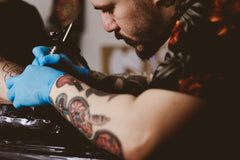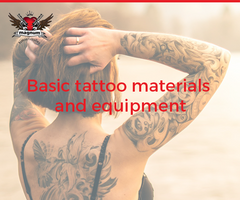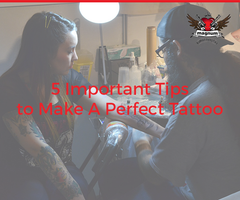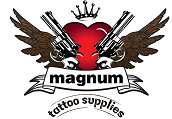Respect the Process | Tattoo Equipment Supplier 0
 Getting your first tattoo can be an anxiety ridden experience, you know it’s going to hurt, no one likes to be hurt, you know you are putting your skin into the hands of a stranger essentially unless you personally know the tattooist then great! There are tonnes of posts on how to prepare for your tattoo, research the studios, speak to the artists, picking a design you love and one that is achievable, but what is it actually like to sit in the chair and get it done? As a tattoo equipment supplier, we are familiar with the process and want to familiarise you so you know exactly what to expect and hopefully conquer at least some of those first tattoo nerves!
Getting your first tattoo can be an anxiety ridden experience, you know it’s going to hurt, no one likes to be hurt, you know you are putting your skin into the hands of a stranger essentially unless you personally know the tattooist then great! There are tonnes of posts on how to prepare for your tattoo, research the studios, speak to the artists, picking a design you love and one that is achievable, but what is it actually like to sit in the chair and get it done? As a tattoo equipment supplier, we are familiar with the process and want to familiarise you so you know exactly what to expect and hopefully conquer at least some of those first tattoo nerves!
Important Tattoo Medical Supplies to Store 0

It's important to keep your tattoo shop stocked with all the tattoo medical supplies needed to prep and modify clients--things like antiseptics, skin cleansers, tattoo bandages, and disinfectants.
Read through the sections below to compare your options within each product category.
Autoclaves & Autoclave Supplies
An autoclave steam steriliser is the single most effective tool for sterilising reusable tattoo supplies like steel grips and tattoo tubes. You'll be able to sterilise larger batches of tools faster and more thoroughly with an autoclave than you could with chemical baths or other sterilisation alternatives.
There are several types of autoclave accessories in store to keep on hand to get the most out of your steam steriliser. Every tool you sterilise will need to be bagged separately before being autoclaved, so it's a good idea to stock up on sterilisation pouches and nylon tubing in a variety of sizes. A heat sealer is also needed to seal your autoclave bags, steam sterilization integrators that clearly show when your tools have been fully sterilised, a reliable autoclave cleaner you can use to clean your steriliser regularly, and spore testing kits so you can periodically test your machine to make sure it's operating optimally.
Cleaners
Tattoo tools have to be thoroughly cleaned before they're autoclaved, and a variety of tools are readily available to simplify the cleaning process.
An autoclave can be a huge time saver for a busy shop. Without an autoclave, you have to hand-scrub all of your reusable tattoo tools, soak them in disinfectant and lubricate them before you sterilise them. If you're interested in shortening the clean-up process in between clients so you can tattoo more people in a day, you need an ultrasonic cleaner.
Tattoo Cleaners, Disinfectants & Bio-Hazard Containers
It's highly critical that you maintain a sterile work environment to keep your clients safe and make them feel secure when they get tattooed in your shop. To keep surfaces sterilised throughout your shop, you'll need an assortment of disinfecting cleaning products. You should also make biohazard containers easily accessible to your tattoo artists so that they can properly dispose of used tattoo needles, other sharps, and contaminated protective gear, like used tattoo machine bags.
Tattoo Covers & Protective Gear
In your efforts to maintain a sterile work environment within your tattoo shop, you should bag all reusable tattoo tools that can't be autoclaved, like tattoo machines and clip cords. Additionally, it's important that your tattoo artists wear medical gloves while tattooing, and that they change them at appropriate intervals. Some artists also like to cover more of themselves, for their health, to prevent cross-contamination and to protect their clothing.
For tattoo gloves, choose from latex and nitrile gloves in a variety of sizes and styles from brands like Defend, Aurelia, Black Dragon, Midknight, Ultraform, and more.
When you're tattooing a client's face or neck, it's best to wear a face mask. These surgical face masks come in boxes of 50 and have ear loops to hold them in place.
Antiseptics, Skin Cleansers & Other Skin Prep Products
Before tattooing a client and after applying any topical anaesthetic requested, you have to perform surgical skin prep. This process requires washing the skin with an appropriate skin cleanser, and then applying a CDC-approved antiseptic. Make sure your client isn't allergic to any of the skin prep products you're planning to use. Some people have iodine allergies while others have sensitivities to fragranced soaps, so it's important to talk to your clients about the tattooing process and products you use before you begin
Top brands like Intenze, Green Soap, Tattoo One, Tattoo Goo, and H2Ocean are just some of the well- known skin cleaners that are being used by tattoo artists, as well as surgical-grade antiseptics like alcohol pads and providone iodine swabs.
- Matthew Nelson
- Tags: Magnum Tattoo Supplies blog MTS blog tattoo anaesthetics tattoo blog tattoo machine tattoo tips UK
Tattoo and its beginnings 0

Having a tattoo in any part of your body seems to be a lot more acceptable in the society today than before. People used to think that tattoos are only seen in the bodies of criminals and the likes. But now, it has even become an accessory to some people.
By using needles and ink, a tattoo is a kind of art that is engraved in the skin permanently. The word tattoo comes from the Tahitian word “tatua”. This means “to mark.” Despite the fact that tattooing have been practised for hundreds of years by people of various cultures, it has gained social acceptance everywhere just recently.
Tattooing eye-catching illustrations to the skin has been a widely known practice since the ancient times. Throughout the centuries, various types of tattoo art have been put into practice by a lot of diverse world cultures. One example is of the Japanese culture. Around 500 B.C., they started using tattoos for cosmetic and religious purposes. They even used it as a punishment for criminals by branding them. This method by the Japanese involved piercing the skin of the individual with fine metal needles in order to craft designs with different colors. In addition, the Eskimo tribes also established their own technique by using bone needles in order to draw the soot-covered thread through the skin.
Over the last 200 years, the art of tattooing kept on growing. In the nineteenth century, this said fame caught the attention of the upper class men of England. One example is Lady Randolph Churchill, mother of Winston Churchill, who had a snake tattoo on her wrist. In the United States, tattoos have been linked to prison inmates, sailors, and motorcyclists because before, tattoo shops were thought to be dangerous and socially unacceptable. But this type of perception has greatly changed since the 1980s. Tattoos are already becoming popular to men and women of all ages all over the world.
“Flash” is what you call a tattoo design. It can be made up of any type of artwork ranging from the simplest symbols or letters to thorough sketches and cartoons. Flash can be composed with different colors. Tattoo parlours show a large variety of flash on their walls with the larger ones having approximately 10,000 to choose from. Also, clients may carry with them their own preferable design or they can work with the tattoo artist to develop custom flash.
Always bear in mind that whenever you choose a tattoo design you must consult with the artist to know a suitable size and placement for the tattoo. The artist can also give you aid in deciding which color schemes to use that will determine the price of the final art. Caring for your tattoo is a must and that is why there is a need to conduct a research whether your tattoo parlour follows the guidelines that were set by the Association of Professional Tattooists (APT).
- Matthew Nelson
- Tags: MTS blog tattoo tattoo artist tattoo blog tattoo ink tattoo machine
Basic Tattoo Materials and Equipment 0

- Flash
The tattoo design or commonly called as “flash” is simply a sketch or a piece of line art that is used to make a tattoo. It can be black, white, or any colour. They are mounted on the walls or displayed in books in the tattoo parlour.
- Stencil
A stencil is just a copy of flash however it is crafted on a special copying paper. The stencil permits the inked outline of the design of the tattoo to be transferred to the client’s skin in order for it to be marked out by the artist.
- Ink
Special inks that are used in order to produce great tattoos are sold by tattoo supply shops. They are usually available in a different kinds of colours and are typically packaged in 4 oz plastic squeeze bottles so they are easily handed out. These inks are liquid dispersions of pigments. They are permitted by the Food and Drug Administration in the United States. The ink is composed of dyes that come from metal components. Due to this reason, allergic reaction to the type of ink used is more likely.
- Tattoo Machine
The tattoo machine is composed of a hand held needle gun attached to a power unit that makes it possible for the pressure to move the needles. The needles can come in different sizes and shapes and are packed jointly on a needle bar in various types of patterns depending on the needs of the artwork. The unit is connected to a power supply that is started by depressing a foot pedal on the floor bedside of the work station. When the pedal is depressed the tattoo needle bar moves up and down quickly. Imagine that of a sewing machine. It makes a way into the skin to inject the dye 3000 times per minute.
- Miscellaneous Supplies
For the whole tattoo procedure the artist may use supplementary supplies like skin disinfectants, petroleum jelly, bandages, razors, and biocidal cleaning supplies.
- Tattoo Removal
Sometimes people with tattoos come to a point in their lives where they decide to have their tattoo removed. Tattoo removal is now possible, thanks to advance technology, however the process is not easy, costly, and sometimes not fully successful. Not so long before, a wire brush was used to rub the skin and wipe out the first and second layers where the ink is present. In order to leach out the ink, salt solutions and acid were used to burn the skin away.
All of these methods are costly, painful, and not very effective. Even though the tattoo can be removed, the affected area may lose its capability to produce normal skin pigment and some scarring will be unavoidable. Today, lasers have been developed to remove tattoos, as it can tear down most of the ink pigment with very little scarring.
Choosing the Right Power Supply 0

A tattoo may represent a lot of things. It is not just the window to a person’s personality, it also shows how the tattoo artist interpreted their client's design. Tattoo artists who care for their clients, and who make an effort to know the needs and wants of the customers will go a long way.
A great tattoo artist gives only the best service to their clients. The make sure they have the right skills and the right equipment. This also includes the equipment used to power their machines.
Here are some of the things you need to check off your "finding-the-perfect-power-supply" list.
1. Determine the voltage required. Tattoo power supplies have a wide range of volt outputs. Some are capable of running as low as 3 and as high as 12 to 15. Some portable power supplies can run to as low as 1.5 volts and larger power supplies can run to as high as 20 volts. Obviously, the higher the voltage would mean more power will be supplied.
2. Choose the type of power supply. Analogue and digital power supplies come in both regulated and unregulated models. Your confidence level and power output reading are factors in choosing the right power supply. It is very important to look at each type available. A digital power supply gives a more accurate reading. The power is easier to check and see, even while you’re working. However, digital power supplies are more expensive. Regulated machines are pricey, but it provides you with a constant voltage even if the tattoo machine isn't running.
3. Consider the fluctuations. The amount of power required at any given time during a tattoo may change depending on the amount of pressure being applied as the tattoo needle pierces the skin. Many regulated machines will help compensate for these fluctuations. Other machines do not. Ask, research, and pick which power supply you feel most comfortable with.
4. Take into consideration your regular tattoo machine. Some tattoo power supplies are only recommended for a coil operated tattoo machine, while others can be used for a rotary machine and still others can be used for both.
5. Think of the number of machines you can hook up. Many tattoo artists prefer to set up a separate machine for lining and another for shading. It's convenient to have a power supply that allows you to plug in two machines at once and just flip a switch to change while the tattoo session is ongoing.
6. Contemplate size, weight and portability. A small tattoo power supply doesn’t automatically mean the power is suppressed. A lot of manufacturers sell compact units for those who want to save space, or for the tattoo artists who travel often.
7. Factor in price. Before deciding if the price is right, carefully take into consideration all of the factors above. You may be able to find more than one reliable machine that meets or exceeds all of your needs. If this is the case, then you start eliminating based on price.
5 Important Tips to Make A Perfect Tattoo 0

A perfect tattoo isn't that easy to achieve, but with the right elements and skills, you can definitely pull off a perfect tattoo.
To accomplish this ultimate goal, keep these 5 important tips in mind.
- Listen to your client
Different clients have different tastes. Some want a detailed tattoo, while others choose simpler ones. Whatever your client prefers, listening to their wants and needs is very important. Communicating with your client is important before and during the tattoo process. Coming up with an actual design based on what they want will depend on your creativity and skills. Draft the design and show it to your client, be open to their comments. Don't hesitate to suggest an idea, if you think it will improve the design. If the design or the size is not feasible, explain it to your client, tell them the reasons why you don't recommend it, and offer them alternatives.
- Pay attention to placement
The design shouldn't be the only focus to achieve a perfect tattoo. Most of the time, clients already know the design and placement they want. As the expert, you should be able to tell whether the design and size will fit the placement they have chosen. If not, don't hesitate to tell them. You can suggest other better placements, or you can suggest adjusting the size of the design. Explain to them and show them the possible outcome if they insist the placement and size they want.
- Consider techniques in advance
Tattoo sessions are usually pre-booked, this gives you an opportunity to study and consider techniques you can use that will give you the best approach. You can even try sketching and using coloured pens to give you a better idea on how you can give justice to your client's chosen design.
- Get to know your equipment
Of course, if you're planning to make this a career you should know every equipment by heart. You should be comfortable with the equipment you will be using. Being uncomfortable with your equipment will affect the overall result of your work. Familiarise your self with all the equipment you will be using, and the brand of ink you choose to use. This will give you overall control during the tattoo process.
- Be realistic.
A good tattoo artist knows their limitations. Knowing is one thing, but admitting and accepting these limitations is different. But that shouldn't stop you from learning and practising new techniques. But if you're not ready, and you know you're not confident that you can achieve the client's desired design, say it to them directly. Accepting projects that are beyond your limitations might lead to a disastrous outcome. You don't want an unhappy client right? Be realistic and be honest. Keep in mind that customers worked hard to save money for their tattoos and they also endure the pain, so they don’t want to end up leaving your shop dissatisfied and traumatised.






